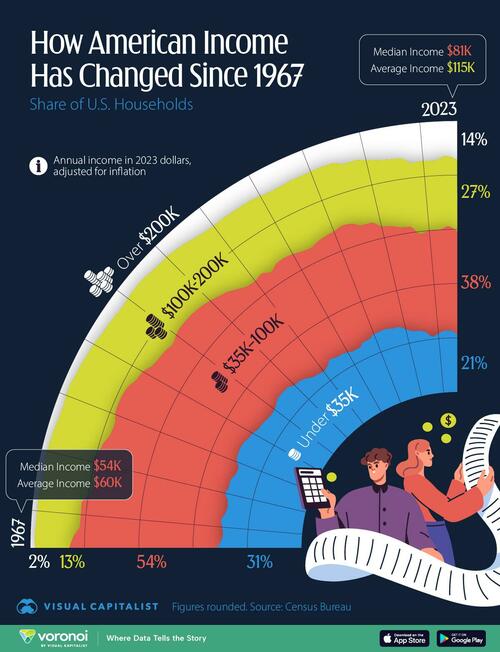
Visualizing How US Household Incomes Have Changed Over The Past 50 Years
This chart, via Visual Capitalist’s Pallavi Rao, tracks the share of U.S. households by annual income bracket from 1967 to 2023.

All annual income is in 2023 dollars, adjusted for inflation, but not for cost of living differences.
Data is sourced from the Census Bureau, published 2024.
Americans Are Making More Money Than Ever Before
Incomes for American households have grown quite a bit in the last six decades.
In 1967, nearly one-third of households made less than $35,000 a year (adjusted to 2023 dollars), and in 2023, that’s fallen to one-fifth.
Here’s the share of households per income bracket for every year since 1967. Categories have been combined from the original source and all figures are rounded. As a result percentages may not sum exactly to 100.
| 1967 | 31.3 | 54.4 | 12.7 | 1.7 |
| 1968 | 29.7 | 54.4 | 14.3 | 1.6 |
| 1969 | 29.1 | 52.8 | 16.2 | 1.9 |
| 1970 | 29.6 | 52.3 | 16.2 | 2 |
| 1971 | 30.2 | 51.8 | 16.1 | 1.9 |
| 1972 | 29.1 | 50.4 | 18.0 | 2.5 |
| 1973 | 28.6 | 49.4 | 19.3 | 2.7 |
| 1974 | 28.9 | 50.4 | 18.3 | 2.4 |
| 1975 | 30.4 | 50.1 | 17.2 | 2.2 |
| 1976 | 29.7 | 49.7 | 18.3 | 2.4 |
| 1977 | 29.8 | 48.7 | 18.9 | 2.6 |
| 1978 | 28.8 | 48.3 | 20.0 | 3.0 |
| 1978 | 28.8 | 48.3 | 20.0 | 3.0 |
| 1979 | 28.4 | 48.4 | 20.1 | 3.1 |
| 1980 | 29.8 | 48.0 | 19.4 | 2.7 |
| 1980 | 29.8 | 48.0 | 19.4 | 2.7 |
| 1980 | 29.8 | 48.0 | 19.4 | 2.6 |
| 1981 | 30.4 | 47.9 | 19.1 | 2.6 |
| 1982 | 30.6 | 47.6 | 18.7 | 3.1 |
| 1983 | 30.4 | 47.3 | 19.2 | 3.2 |
| 1984 | 29.5 | 46.6 | 20.4 | 3.6 |
| 1985 | 29.0 | 46.4 | 20.8 | 3.8 |
| 1985 | 29.0 | 46.4 | 20.8 | 3.8 |
| 1986 | 28.0 | 45.5 | 22.0 | 4.5 |
| 1987 | 27.8 | 45.1 | 22.5 | 4.7 |
| 1988 | 27.2 | 45.2 | 22.6 | 5.0 |
| 1989 | 26.9 | 44.7 | 23.1 | 5.4 |
| 1989 | 26.9 | 44.7 | 23.1 | 5.4 |
| 1990 | 27.1 | 45.5 | 22.4 | 5.1 |
| 1991 | 28.0 | 45.1 | 22.0 | 4.9 |
| 1992 | 28.8 | 44.2 | 22.1 | 4.9 |
| 1993 | 28.7 | 44.1 | 21.8 | 5.4 |
| 1994 | 28.6 | 43.7 | 22.0 | 5.8 |
| 1995 | 27.4 | 44.0 | 22.8 | 5.8 |
| 1996 | 27.2 | 43.2 | 23.4 | 6.3 |
| 1997 | 26.3 | 43 | 23.8 | 6.9 |
| 1998 | 25.1 | 42.6 | 24.7 | 7.7 |
| 1999 | 24.6 | 41.6 | 25.5 | 8.3 |
| 2000 | 24.2 | 41.8 | 25.5 | 8.6 |
| 2001 | 24.9 | 41.9 | 24.9 | 8.4 |
| 2002 | 25.2 | 37.1 | 25.1 | 8.1 |
| 2003 | 25.7 | 41.0 | 24.8 | 8.4 |
| 2004 | 25.6 | 41.4 | 24.6 | 8.4 |
| 2005 | 25.2 | 41.5 | 24.6 | 8.8 |
| 2006 | 24.6 | 41.3 | 24.9 | 9.2 |
| 2007 | 24.6 | 40.9 | 25.3 | 9.1 |
| 2008 | 25.9 | 40.7 | 24.6 | 8.8 |
| 2009 | 26.1 | 41.4 | 24.0 | 8.8 |
| 2010 | 27.1 | 40.6 | 23.7 | 8.6 |
| 2011 | 27.3 | 41.4 | 23.0 | 8.4 |
| 2012 | 27.4 | 40.8 | 23.4 | 8.4 |
| 2013 | 26.8 | 39.6 | 23.6 | 9.8 |
| 2014 | 26.8 | 39.8 | 23.7 | 9.8 |
| 2015 | 25.3 | 39.0 | 25.2 | 10.5 |
| 2016 | 24.2 | 39.5 | 24.9 | 11.5 |
| 2017 | 23.8 | 38.7 | 25.4 | 12.1 |
| 2018 | 23.0 | 39.2 | 25.6 | 12.3 |
| 2019 | 21.0 | 38.0 | 26.5 | 14.6 |
| 2020 | 21.8 | 38.1 | 25.8 | 14.2 |
| 2021 | 22.7 | 37.1 | 25.7 | 14.4 |
| 2022 | 22.7 | 38.5 | 26.0 | 12.9 |
Meanwhile, the other end of the spectrum is seeing growth in the bracket size. In 1967, fewer than 2% of American households made more than $200,000 per year. In 2023, that number had risen to 15%.
Of course, there’s an increase in labor to also be accounted for. Six decades ago, only one-third of all U.S. households had all parents working. By 2009, the situation had reversed.
What This Chart Doesn’t Tell Us
Lastly, looking at incomes is only one half of the story. It doesn’t account for how prices of goods and services have changed relative to growing incomes.
Houses for example cost about 3x the median income in 1967, and in 2022 cost nearly 6x the median income.
However, the vast majority of consumer goods are much cheaper now, relative to incomes, due to how manufacturing has moved out to other parts of the world.
Food is also much cheaper, dropping from 15% of household income in 1967, to around 7% in 2022 – the year when record food inflation had pushed prices up.
Naturally, incomes vary quite a lot across the country. Check out Mapped: Median Income by State in 2024 to see by how much.
Tyler Durden
Thu, 12/26/2024 – 23:00
















